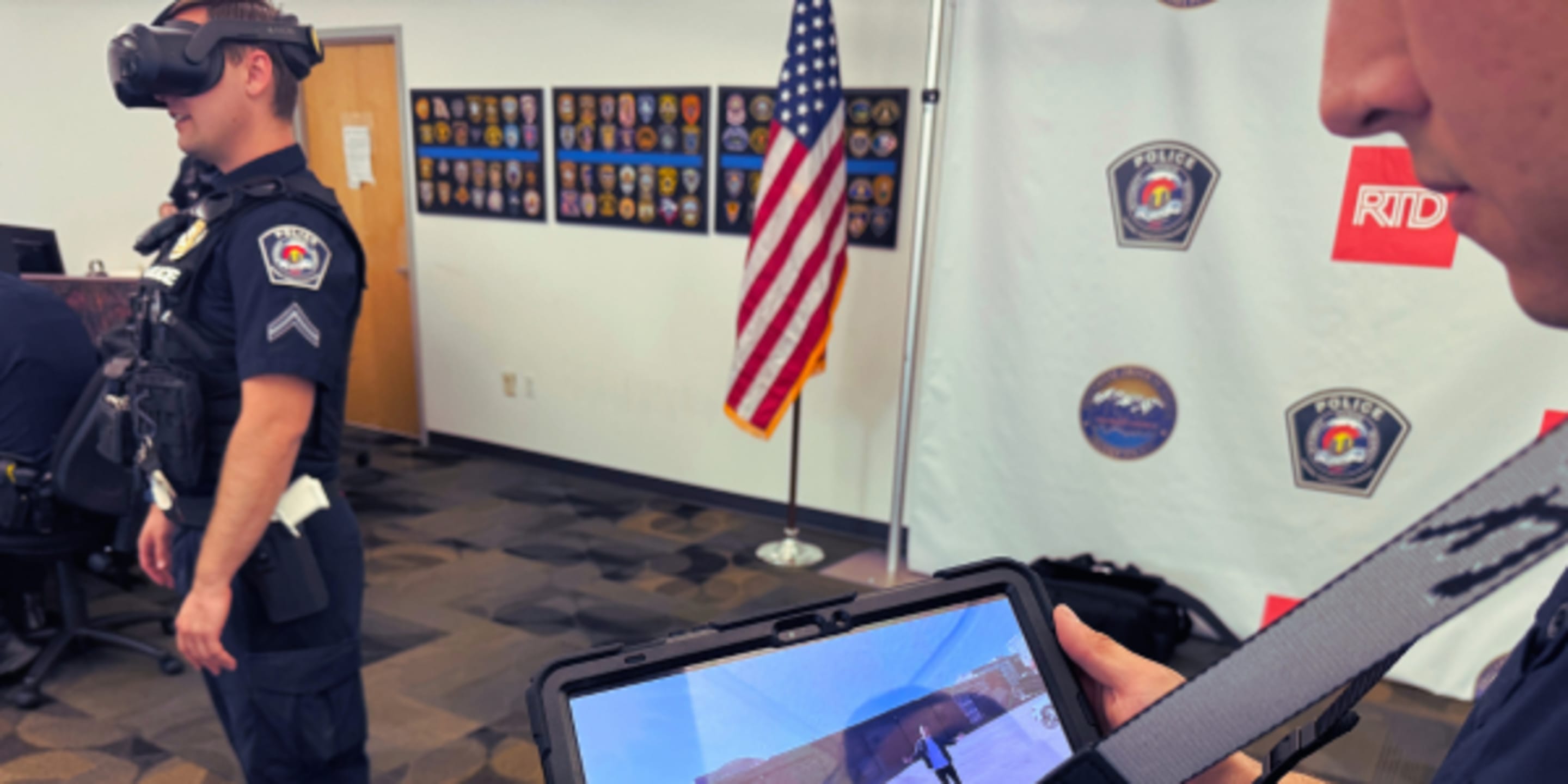
RTD Transit Police uses virtual reality technology to build upon real world technical skills
DENVER (Sept. 2, 2025) –– The Regional Transportation District (RTD) is using virtual reality technology to augment its training program for Transit Police officers to learn how to safely assess a multitude of situations and address threats. The virtual reality technology offers reality-based training scenarios for officers to safely hone skills and supports certification in using TASERs. Almost half of the 100 sworn officers in the Transit Police Department (RTD-PD) have completed the reality-based training since the program was implemented in June. The program is taught by two of RTD-PD’s certified Master Taser instructors, Corporal Jacob Schubert and Corporal Chance Fitzgerald.
Through the technology, officers see and hear a simulated environment requiring them to take the best course of action and safely use TASERs. The technology manufacturer and service provider, Axon, currently provides 12 scenarios and continues to add more for officers to build upon their technical skills and refine in-the-moment decision-making. The technology enables officers to progressively build skills, even accounting for factors such as the physical and mental state of the individual in the scenario, whether they’re standing, sitting or partially obscured––right down to the details of the clothing a person may be wearing and how that would impact the use of TASERs.
The RTD-PD elected to implement the technology for a variety of benefits, including the ability to safely train officers without the use of live rounds from TASERs. The system’s headset and tablet device are portable, enabling training to be conducted in many locations. Transit Police brings the virtual reality training to almost every in-service training to maximize the ability of officers to use the technology.
Reality-based training is also cost-effective for its ability to take officers through approximately 1,000 virtual deployments versus roughly eight to 10 deployments annually with live training. The training can also be conducted in regular 15-to-20-minute sessions rather than taking officers off their regular work assignments for a training day. The virtual reality trainings are easily repeated, and the Transit Police Department receives immediate feedback about an officer’s test scenario.
Officers need to score at least 80% in each reality-based module with the results available to evaluate officer performance by applying evidence-based training standards and methods to facilitate improvements. The results are available to the department at any time, and the program facilitates officers’ ability to continually learn, improve and build upon existing skills. Schubert said officers can ideally run through training at least weekly, though addressing patrols and responding to calls remain the department’s top priority.
“RTD-PD is dedicated to advancing technology to better serve our officers and the community. This training equips our officers with the skills they need to effectively handle real-world situations they may encounter in the field," RTD Chief of Police and Emergency Management Steve Martingano said.
The learning reinforces officers’ ability to proficiently evaluate circumstances. “With different types of scenarios, we can put the officer in the shoes of somebody who may be experiencing a medical or mental health crisis so they can better understand what the person is going through,” noted Schubert. “In-depth reality-based training helps officers with quick decision-making and what different options we could take.”
Schubert and Fitzgerald first experienced the virtual reality equipment a year and a half ago during their training at Axon’s Master Taser Instructor School in spring 2024 where they became certified master TASER instructors for the Transit Police. He immediately appreciated the modality’s ability to provide a completely safe training environment with numerous scenarios for officers to hone their skillsets.
“We are now able to put an officer in a virtual reality environment so that they can be on the range without any live TASER cartridges and have similar, if not, better training in a static environment,” Schubert said.
With AI advancements, it is anticipated the training modules will evolve and benefit the program with future modules allowing for two-way communication with virtual suspects to better prepare officers for real world scenarios. The training’s virtual reality technology is built to represent the identical size, weight and capabilities of real-life TASER counterparts.
The virtual reality program costs RTD-PD approximately $170,000 a year for six headsets and tablets to directly view an officer’s actions in the simulated environment, and it provides access to performance metrics. Program costs are offset by the ability to provide a safe and versatile training environment for officers, as well as being able to keep officers on patrol while offering periodic bursts of training in about 20-minute intervals. This reduced time for training means tens of thousands of dollars are saved on training field days and the associated costs for equipment and staff time.